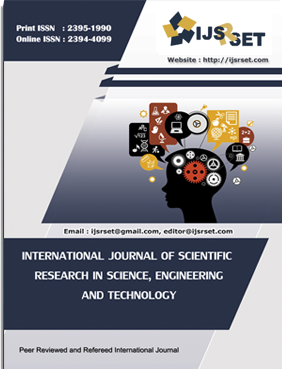Effect of Pressure and Temperature on Shock Wave Propagation in Conducting Gas
DOI:
https://doi.org/10.32628/IJSRSET2512336Keywords:
Shock wave propagation, Conducting gas, Pressure, Temperature, Fluid dynamics, ThermodynamicsAbstract
This study aims to investigate the effects of pressure and temperature on shock wave propagation in conducting gases, focusing on how these variables influence shock wave amplitude, speed, and structure. A theoretical framework is developed to derive the governing equations for shock wave evolution, discontinuity formation, and disturbance propagation, which facilitates an analysis of the gas's thermodynamic properties and their impact on shock behaviour. The findings reveal that increased pressure steepens the pressure gradient and enhances shock wave strength, while higher temperatures provide gas molecules with additional kinetic energy, altering ionization levels and propagation speeds. The interplay between temperature and pressure significantly affects shock wave dynamics, which is crucial for applications in aerospace, engineering, and astrophysics involving high-energy technologies and propulsion systems. Understanding these dynamics is essential for effectively designing systems that utilize shock waves.
📊 Article Downloads
References
Cheng, L., Ji, C., Zhong, M., Long, Y., & Gao, F. (2019). Full-scale experimental investigation on the shock-wave characteristics of high-pressure natural gas pipeline physical explosions. International Journal of Hydrogen Energy, 44(36), 20587-20597. DOI: https://doi.org/10.1016/j.ijhydene.2019.06.005
Chi, L. Y., Zhang, Z. X., Aalberg, A., Yang, J., & Li, C. C. (2019). Measurement of shock pressure and shock-wave attenuation near a blast hole in rock. International Journal of Impact Engineering, 125, 27-38. DOI: https://doi.org/10.1016/j.ijimpeng.2018.11.002
Duan, Q., Xiao, H., Gong, L., Li, P., Zeng, Q., Gao, W., & Sun, J. (2019). Experimental study of shock wave propagation and its influence on the spontaneous ignition during high-pressure hydrogen release through a tube. International Journal of Hydrogen Energy, 44(40), 22598-22607. DOI: https://doi.org/10.1016/j.ijhydene.2019.06.166
Kosuge, S., Kuo, H. W., & Aoki, K. (2019). A kinetic model for a polyatomic gas with temperature-dependent specific heats and its application to shock-wave structure. Journal of Statistical Physics, 177(2), 209-251. DOI: https://doi.org/10.1007/s10955-019-02366-5
Li, P., Duan, Q., Gong, L., Jin, K., Chen, J., & Sun, J. (2019). Effects of obstacles inside the tube on the shock wave propagation and spontaneous ignition of high-pressure hydrogen. Fuel, 236, 1586-1594. DOI: https://doi.org/10.1016/j.fuel.2018.09.120
Li, P., Duan, Q., Jin, K., Zeng, Q., & Sun, J. (2021). Experimental study on shock waves, spontaneous ignition, and flame propagation produced by pressurized hydrogen release through tubes with varying obstacle location. Fuel, 290, 120093. DOI: https://doi.org/10.1016/j.fuel.2020.120093
Li, Y., Jiang, Y., Pan, X., Wang, Z., Hua, M., Wang, Q., ... & Jiang, J. (2021). Effects of the arc-shaped corner on the shock wave and self-ignition induced by sudden release of pressurized hydrogen. Fuel, 303, 121294. DOI: https://doi.org/10.1016/j.fuel.2021.121294
Mursenkova, I. V., Znamenskaya, I. A., & Lutsky, A. E. (2018). Influence of shock waves from plasma actuators on transonic and supersonic airflow. Journal of Physics D: Applied Physics, 51(10), 105201. DOI: https://doi.org/10.1088/1361-6463/aaa838
Nath, G. (2019). Cylindrical shock wave generated by a moving piston in a rotational axisymmetric non-ideal gas with conductive and radiative heat-fluxes in the presence of azimuthal magnetic field. Acta Astronautica, 156, 100-112. DOI: https://doi.org/10.1016/j.actaastro.2018.10.041
Sembian, S., & Liverts, M. (2020). On using converging shock waves for pressure amplification in shock tubes. Metrologia, 57(3), 035008. DOI: https://doi.org/10.1088/1681-7575/ab7f99
Wang, Z., Pan, X., Jiang, Y., Wang, Q., Li, Y., Xiao, J., ... & Jiang, J. (2020). Experimental study on shock wave propagation and spontaneous ignition induced by high-pressure hydrogen suddenly released into T-shaped tubes. Safety science, 127, 104694. DOI: https://doi.org/10.1016/j.ssci.2020.104694
Zeng, Q., Duan, Q., Sun, D., Li, P., Zhu, M., Wang, Q., & Sun, J. (2020). Experimental study of methane addition effect on shock wave propagation, self-ignition and flame development during high-pressure hydrogen sudden discharge from a tube. Fuel, 277, 118217. DOI: https://doi.org/10.1016/j.fuel.2020.118217
Zhang, Q., Qian, X., Chen, Y., & Yuan, M. (2020). Deflagration shock wave dynamics of DME/LPG blended clean fuel under the coupling effect of initial pressure and equivalence ratio in elongated closed space. Journal of Cleaner Production, 250, 119572. DOI: https://doi.org/10.1016/j.jclepro.2019.119572
Zhang, Q., Qian, X., Fu, L., Yuan, M., & Chen, Y. (2020). Shock wave evolution and overpressure hazards in partly premixed gas deflagration of DME/LPG blended multi-clean fuel. Fuel, 268, 117368. DOI: https://doi.org/10.1016/j.fuel.2020.117368
Zhou, A., Wang, K., Feng, T., Wang, J., & Zhao, W. (2018). Effects of fast-desorbed gas on the propagation characteristics of outburst shock waves and gas flows in underground roadways. Process Safety and Environmental Protection, 119, 295-303. DOI: https://doi.org/10.1016/j.psep.2018.08.016
Downloads
Published
Issue
Section
License
Copyright (c) 2025 International Journal of Scientific Research in Science, Engineering and Technology

This work is licensed under a Creative Commons Attribution 4.0 International License.




